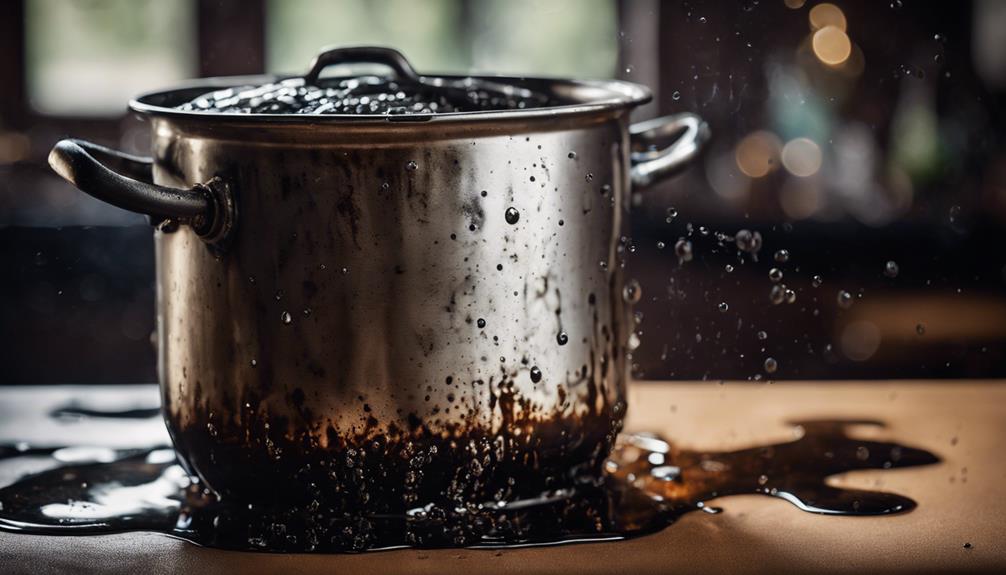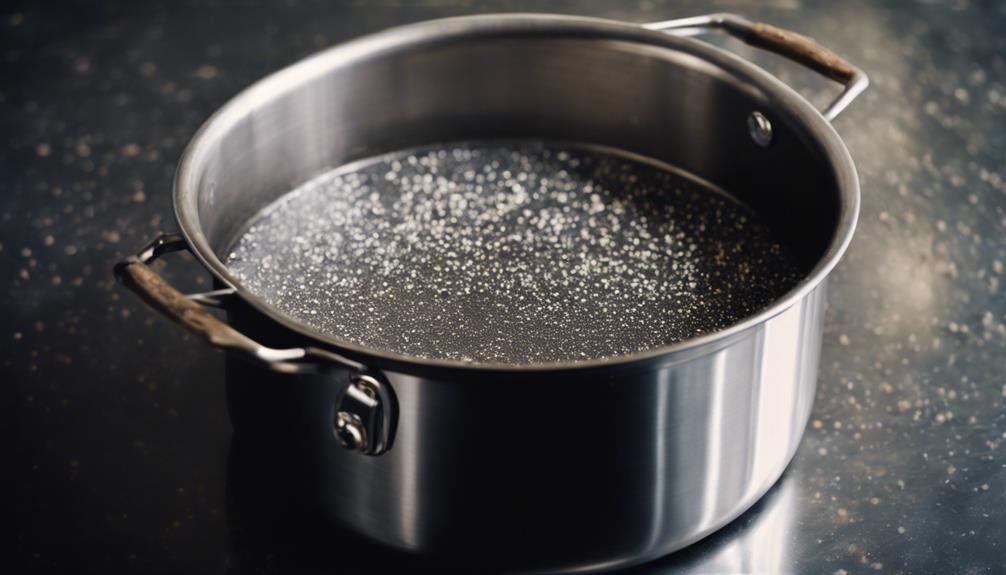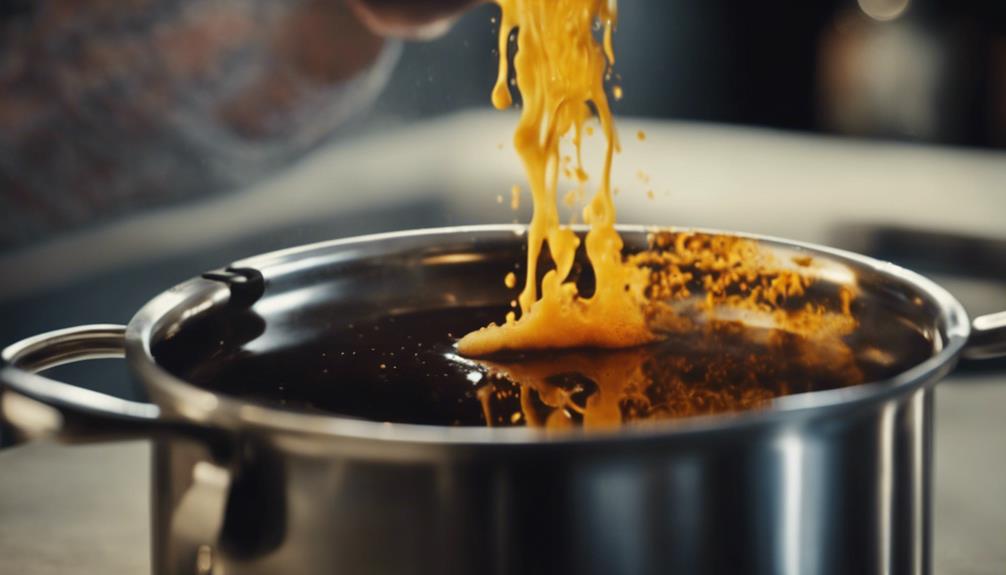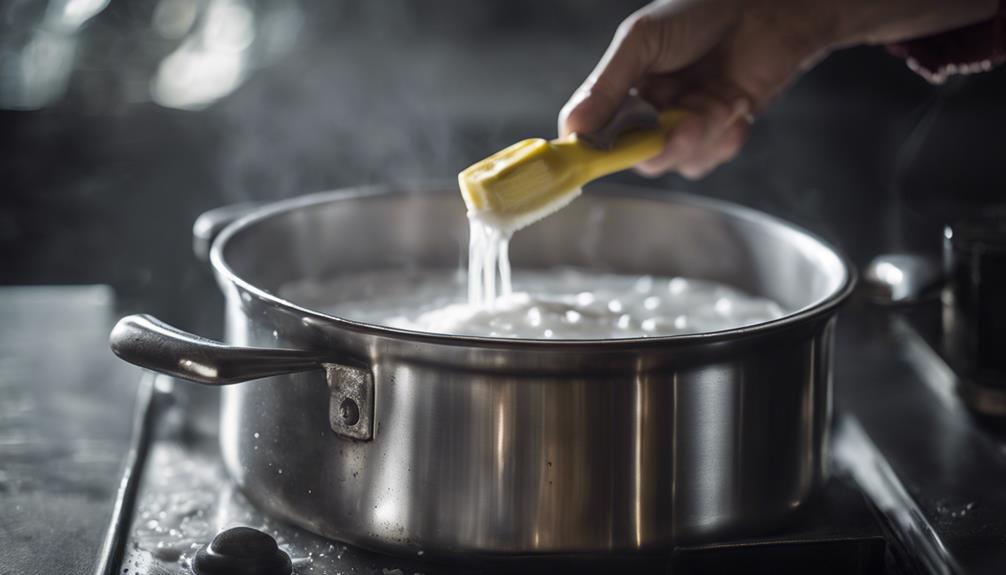If you've got a scorched stainless steel pot, try these cleaning tips! Make a paste with baking soda and water. Apply it generously, scrub well, then rinse. Or simmer baking soda and water in the pot to loosen burnt bits. Soak the pot in cola or use a mix of cream of tartar and water overnight. Try a gentle scrub with dish soap and eco-scrub or a lime and salt scrub. For more ways to get your pot back to its shiny self, keep exploring the different effective cleaning methods listed!
Baking Soda Paste Method
To clean a scorched stainless steel pot using the baking soda paste method, start by creating a paste of baking soda and water. Apply this paste generously over the burnt areas of the pot, ensuring they're thoroughly covered.
Let the baking soda paste sit on the scorched spots for about 15-20 minutes to allow it to work its magic in loosening the stubborn burnt-on food.
After the paste has had time to sit, take a nylon brush or scouring sponge and scrub the pot vigorously to remove the burnt residue effectively. The gentle abrasiveness of the baking soda paste will aid in lifting off the burnt-on food without scratching the stainless steel surface.
Once you have scrubbed the pot, rinse it thoroughly with warm soapy water to remove any remaining baking soda residue.
This baking soda paste method is a safe and effective way to clean scorched stainless steel pots, leaving them looking as good as new without causing any damage to the pot's surface.
Simmering Baking Soda & Water
To effectively clean a scorched stainless steel pot, start by simmering a mixture of baking soda and water. This method helps loosen burnt-on food and neutralizes residues for easier scrubbing.
After simmering, gently scrub the pot to remove charred debris, then rinse and dry for a sparkling clean finish.
Baking Soda Paste
For simmering baking soda and water to create a paste, cover the scorched portion of the stainless steel pot.
This baking soda paste acts as a gentle yet effective solution for tackling burnt-on food and stubborn stains. The simmering process helps loosen the burnt bits, making them easier to scrub away.
Baking soda's mild abrasive properties aid in the scrubbing process, while its alkaline pH works to neutralize odors and lift grime from the pot surface.
After scrubbing with the baking soda paste, be sure to rinse the pot thoroughly to reveal a clean and shiny finish. This method is particularly useful for stainless steel pots, as it helps maintain the pot's integrity while effectively removing tough stains.
With a little bit of baking soda and water, you can restore your scorched stainless steel pot to its former glory without harsh chemicals or excessive scrubbing.
Gentle Scrubbing Technique
Using a gentle scrubbing technique with simmering baking soda and water can effectively lift burnt-on food particles from a scorched stainless steel pot. The alkaline properties of baking soda help neutralize burnt residues without damaging the stainless steel surface.
To implement this method, start by simmering a mixture of baking soda and water in the pot. Let it bubble and work its magic for a few minutes to break down the tough burnt-on stains. The simmering action loosens the burnt food, making it easier to remove.
Once simmered, grab a non-abrasive scrubbing pad and gently scrub the pot's interior. The softened burnt debris should lift off with ease, revealing a cleaner surface underneath.
This non-abrasive approach is ideal for maintaining the integrity of your stainless steel pot while effectively tackling those stubborn burnt-on residues.
Rinse and Dry
How can you guarantee the effective removal of burnt-on residue from your scorched stainless steel pot after simmering baking soda and water?
After gently scrubbing the pot with a non-abrasive sponge or scrub brush while the baking soda mixture is warm, the next vital step is to rinse and dry the pot thoroughly.
Start by rinsing the pot with hot water to remove any loose burnt food particles that have been lifted by the baking soda mixture. Make sure that you rinse the pot thoroughly to eliminate all remnants of the burnt-on residue.
Once rinsed, dry the pot completely to prevent any remaining burnt stains. Drying the pot will also help in maintaining the stainless steel finish.
Cola Soaking Technique

Consider soaking your scorched stainless steel pot in cola as a powerful method to loosen tough burnt-on messes and make cleaning easier. The acidity of cola is effective in breaking down stubborn burnt residues, making them easier to remove.
To utilize the cola soaking technique, gently simmer your pot with cola on the stove. This process helps to soften the burnt-on mess, allowing you to scrape it off more effortlessly afterward. Cola can serve as an alternative cleaning method for tackling burnt stainless steel pots, offering a convenient and cost-effective solution.
Cream of Tartar Soak
To effectively clean a scorched stainless steel pot, try soaking it in a mixture of cream of tartar and water overnight to loosen burnt-on food particles. Here's why this method works:
- Natural Cleaning Power: Cream of tartar, with its acidic properties, is excellent for breaking down tough burnt-on food residues without harsh chemicals.
- Gentle but Effective: The acidity of cream of tartar helps to soften and dissolve burnt-on messes, making it easier to scrub them off the next day.
- Eco-Friendly Solution: This cream of tartar soak isn't only effective but also environmentally friendly, offering a sustainable way to restore the shine of your stainless steel pot.
Dish Soap & Eco-Scrub

For effective cleaning of a scorched stainless steel pot, combine dish soap and water in the pot to create a cleaning solution. Bring this mixture to a simmer to help loosen the burnt-on food residue gently.
If the scorch marks prove stubborn, let the pot soak overnight to allow the soap to break down the grime effectively.
When tackling the residue, make sure to use an eco-friendly scrubber or sponge to gently remove the burnt-on food without harming the stainless steel surface. This method is ideal for dealing with light to moderate burnt food stains and is known to be gentle on stainless steel pots.
Lime & Salt Scrubbing
When tackling tough burnt-on food stains in your stainless steel pot, consider using a natural and eco-friendly method known as lime and salt scrubbing. This technique harnesses the acidic power of lime juice and the abrasive nature of salt to effectively loosen stubborn burnt-on food residue without damaging your stainless steel pot.
Here's how to do it:
- Create the Scrub: Squeeze fresh lime juice over the burnt areas in the pot and sprinkle a generous amount of salt.
- Let it Sit: Allow the lime and salt mixture to sit for about 30 minutes to work its magic and break down the burnt-on food.
- Scrub Away: Grab a scouring sponge and gently scrub the pot in circular motions, focusing on the areas with burnt residue. The combination of lime juice and salt will help lift off the burnt bits, leaving your pot clean and shiny.
This eco-friendly method offers a natural way to tackle tough burnt-on stains without harsh chemicals.
Deglazing With Vinegar

You can harness the power of vinegar to deglaze your scorched stainless steel pot effectively.
By utilizing the acidic properties of vinegar, you can break down stubborn burnt-on food residue with ease.
Follow the simple steps to deglaze with vinegar and restore your pot to its pristine condition.
Vinegar's Deglazing Power
To explore vinegar's deglazing power when cleaning a scorched stainless steel pot, start by combining it with water to create a solution that effectively lifts and dissolves burnt-on food particles. Vinegar's acidity plays a key role in breaking down stubborn burnt food residue, making it a valuable tool in restoring your pots and pans.
Here's how vinegar's deglazing power can benefit you:
- Effective Cleaning: The acidity in vinegar helps to loosen burnt-on food particles, making them easier to remove from the stainless steel surface.
- Gentle on Cookware: Vinegar's deglazing action is tough on burnt stains but gentle on your stainless steel pots, preserving their quality over time.
- Time-Saving Solution: By utilizing vinegar's deglazing power, you can cut down on scrubbing time and effort, achieving a cleaner pot with less work.
Next, we'll explore the 'Benefits of Deglazing' to further understand how this technique can enhance your cleaning process.
Benefits of Deglazing
Deglazing with vinegar enhances the cleaning process by effectively loosening burnt-on food and stains in stainless steel pots. The importance of vinegar plays a significant role in breaking down stubborn residue, making it easier to remove compared to scrubbing alone.
When combined with water, vinegar creates a powerful deglazing solution that can tackle even the toughest scorched pans. This method not only helps in cleaning burnt stainless steel pots but also offers a natural and chemical-free approach, making it environmentally friendly.
By utilizing the deglazing technique with vinegar, you can save time and effort while achieving impressive results. The natural properties of vinegar make it a versatile solution for removing burnt-on food and stubborn stains from stainless steel pots, ensuring a cleaner and shinier finish without the need for harsh chemicals.
Try deglazing with vinegar for a simple, effective, and eco-friendly way to clean your scorched pans.
Steps to Deglaze
When deglazing with vinegar to clean a scorched stainless steel pot, prepare a water-vinegar mixture to effectively loosen burnt-on food residue. Here are the steps to deglaze your burnt stainless steel pan:
- Let the Pan Cool: Allow the scorched pan to cool before attempting to clean it to prevent any burns or further damage.
- Let the Mixture Sit: Pour the water-vinegar solution into the cooled pan and let it sit for about 10-15 minutes to penetrate the scorched marks.
- Deglaze the Bottom: Heat the pan with the mixture on low heat, stirring and scraping the bottom to deglaze and lift the stubborn burnt bits effectively.
Vinegar or lemon juice are common ingredients used for this method due to their acidic properties, which aid in breaking down the carbonized food residue.
Lemon & Baking Soda Method
For cleaning a scorched stainless steel pot, try out the effective and gentle Lemon & Baking Soda Method.
To begin, cut a lemon in half and sprinkle baking soda generously over the burnt areas of the pot.
Next, use the lemon halves to scrub the stains, creating a mild abrasive paste that helps restore the shine to your cookware.
This cleaning method is particularly useful for eliminating burnt-on residue without the need for harsh chemicals.
The natural acidity of the lemon, combined with the abrasive properties of the baking soda, makes this approach gentle yet effective.
By utilizing the Lemon & Baking Soda Method, you can easily clean and shine stainless steel or copper pots, leaving them looking like new.
Say goodbye to stubborn stains and burnt spots with this simple yet powerful cleaning technique that will have your stainless steel pot gleaming in no time.
Cream of Tartar Overnight Soak

To effectively clean a scorched stainless steel pot, consider utilizing a Cream of Tartar Overnight Soak. This eco-friendly and gentle method can work wonders on stubborn burnt-on food.
Here's how to do it:
- Create the Soaking Mixture: Mix water and cream of tartar to create a solution that will help lift the burnt-on residue from your stainless steel pot.
- Soak Overnight: Submerge the scorched pot in the cream of tartar mixture and let it sit overnight. This allows the powerful properties of cream of tartar to work their magic and loosen the burnt bits effectively.
- Wipe Clean: In the morning, simply wipe the pot clean to reveal a stainless steel surface free of scorch marks. The gentle yet powerful nature of cream of tartar makes it a fantastic option for tackling tough stains without harsh chemicals.
Conclusion
So there you have it, nine different ways to clean a scorched stainless steel pot. Which method will you try first to restore your pot to its former glory?
Don't let a little burnt food ruin your cookware – give these tips a try and get back to cooking up your favorite dishes in no time!